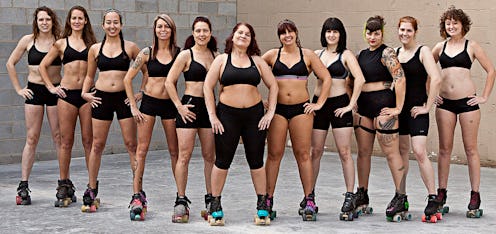
If someone asked you, “What does an athlete look like?”, what would you say? Here's an idea: Hold up a few photographs from “Body by Derby.” A photography project by Cory Layman, “Body by Derby” celebrates both the world of roller derby and the women who comprise it — and much, much more. It's magnificently body positive, and proof that there are an infinite number of answers to the question of what an athlete looks like.
Part of a larger project, the Rollergirl Project, “Body by Derby” was inspired by images from Howard Schatz's book Athlete. Published in 2002, the book featured photographs of professional athletes from a huge array of different sports — proving that there's no single “athletic” body type in the process. Layman's project accomplishes this goal as well, while also taking it a step further: He celebrates the the individuality not only of each derby girl's body, but also of her whole self. Said Layman to Mic:
“Ask me this question [what derby girls are like] three years ago and I would have given you the soundbite you'd expect: Derby girls are strong, athletic, and made of stern stuff. That is mostly true, but it's only half the story. Derby girls are women. Short women, tall women, thin women, fat women, trans women, straight, gay, bisexual, asexual, pansexual, married, single, poly, all ages, all races. There's also a whole lot more.”
Layman began the Rollergirl Project in 2007, chronicling the amazing feats that go down on roller derby tracks all over the country. “Body by Derby” in particular aims to show “the different body types of active skaters and the physical effects derby has on players” — as well as that “perfection is not required to be a strong, capable skater.” And the sheer variety of women featured in the series? To say that they're inspiring doesn't really do them justice. On their own, they're incredible, and together, they're nothing short of spectacular. They are, as Layman said, all types, and they show exactly how important individuality is — both in sports and in everything else.
Looking at “Body by Derby,” I'm reminded a lot of Taylor Townsend, the 18-year-old tennis champ who was asked to sit out of the 2012 U.S. Open Junior tournament because of her weight — even though she was the world's number one junior girl's player at the time. Townsend was (and is) by no means unhealthy; on the contrary, she's significantly more fit that most of us can probably claim. But because she didn't look like the “typical athlete” (whatever that is), she was unfairly shut out of an important tournament. For some reason, we have these rigidly defined ideas of what each “body type” should look like — and when people don't ascribe to it, we assume that's a bad thing, even though the “type” is a more or less arbitrary assignation in the first place.
The proof, as they say, is in the pudding: Townsend ended up attending the U.S. Open Junior that year on her own that year — that is, without the support of the U.S. Tennis Association — and won a boatload of titles at it and successive tournaments as well.
So, too, with the women depicted in “Body by Derby”: Although, as Layman noted, it's only half the story, they are strong, athletic, and made of stern stuff. They are so much more than the sum of our parts, and they are proof that we need to realign how we think of what an athlete is — and what bodies are as a whole. Bodies are amazing: They run, jump, play, move relax, dance, and more. They're worth celebrating — all of them — no matter what.
As Layman told the Huffington Post, “It's not what you look like, it's what you can do on the track. My hope is that someone can look through these images and find someone very similar to themselves. They can then see the beauty and power that person has and realize that they too are beautiful and powerful.” Ayyyyyy-men.
See the full series over at Cory Layman's page, and find out more about the Rollergirl Project here.
Images: Courtesy Cory Layman